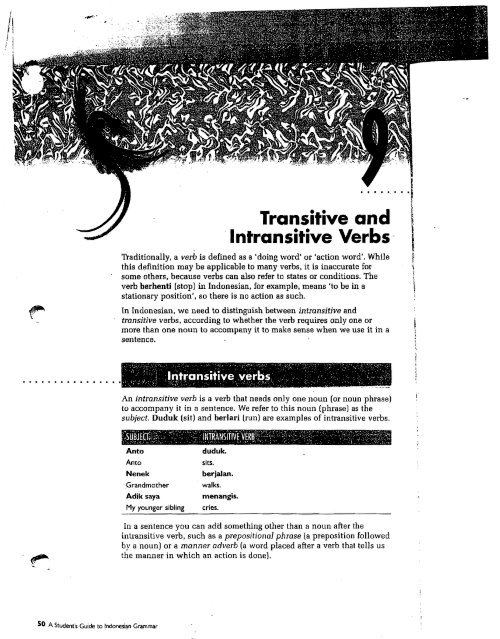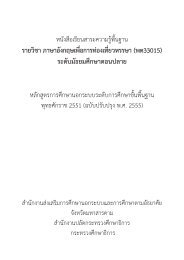- Page 1: ahasa indonesia milik widya DEPARTM
- Page 4 and 5: Contents Introduction Acknowledgmen
- Page 6 and 7: - - 14 Ter- 1 4.1 Adjective ter- 14
- Page 9 and 10: Introduction I A Student's Guide to
- Page 11 and 12: Source Acknowledgments The author a
- Page 13 and 14: Question woril: & itu apel? Is that
- Page 15 and 16: MANA Mana is used in questions, usu
- Page 17 and 18: Anda guru, bukan? You are a teacher
- Page 19 and 20: A: Karnu pernah rnakan durian? Have
- Page 21 and 22: 1 A: Murid boleh merokok di sekolah
- Page 24 and 25: I . 3 nni's teacher's house In this
- Page 26 and 27: I In this type of-noun phrase, the
- Page 28 and 29: -4 Translate the following more com
- Page 30 and 31: Numbers, Classifiers and Quantity ?
- Page 32 and 33: I wv - LUJ- laLua 50 = h a puluh +
- Page 34 and 35: ~iJcewise, we can also &&d@& no&'fi
- Page 36 and 37: 1 1 11 TO show quantity, we can use
- Page 38 and 39: When used to say 'the person who(m)
- Page 42 and 43: pulang selesai singgah tahu terbang
- Page 44 and 45: g'$J Mote Some intransitive verbs c
- Page 46 and 47: pasang rnemasang to set up, install
- Page 48 and 49: Mereka ' membaca buku. They read a
- Page 50 and 51: A 5 tierlibur 6 mencuri 7 berbelanj
- Page 52 and 53: Did you knowt The word beruang can
- Page 54 and 55: elanja to shop berbelan ja to shop
- Page 56 and 57: -. lATlHAN 3 Working in pairs, choo
- Page 58 and 59: I In this chqptei we will learn mor
- Page 60 and 61: 13 kepit 14 umpat 15 ambil 16 ekor
- Page 62 and 63: To go to where the base word indica
- Page 64 and 65: 6 Presiden itu menpinap di hotel bi
- Page 66 and 67: 4 The suffix -kan is often attached
- Page 68 and 69: *- 4 Complete each of the following
- Page 70 and 71: 3 a membaca (read) b membacakan (re
- Page 72 and 73: Some meN-kan words can be adjective
- Page 74 and 75: Summary MeN-kan words are primarily
- Page 76 and 77: To act in the manner of i bai k bin
- Page 78 and 79: antar to take somethinghomeone some
- Page 80 and 81: erdiam di to live in mendiami to oc
- Page 82 and 83: When term is affixed to adjectives,
- Page 84 and 85: Accidental action: intransitive Ter
- Page 86 and 87: You can also leave out the 'by phra
- Page 88 and 89: terbangun to be woken by something
- Page 90 and 91:
........,( Ke-an In grammatical ter
- Page 92 and 93:
In this case, the meaning of ke-an
- Page 94 and 95:
1 04 A Student's Guide to Indonesia
- Page 96 and 97:
Some ke--an words have two meanings
- Page 98 and 99:
Words with the peN- prefix are usua
- Page 100 and 101:
1 10 A Student's Guide to Indonesia
- Page 102 and 103:
3 Pemakan daging 4 Pembuka kaleng 5
- Page 104 and 105:
* * * . *.. **** I' Like other affi
- Page 106 and 107:
LATIHAH 2 Tkanslate these noun phra
- Page 108 and 109:
Summary The majority of words with
- Page 110 and 111:
MeN-kan and meN-i Some peN-an nouns
- Page 112 and 113:
Other percan nouns Some other per-a
- Page 114 and 115:
Subiect-focus and The terms subject
- Page 116 and 117:
LATlHAN I Now that you have learnt
- Page 118 and 119:
Summary of the rules First or secon
- Page 120 and 121:
Object-focus with auxiliary, prepos
- Page 122 and 123:
6 Pak Totok menjual buah-buahan di
- Page 124 and 125:
' 4 Look at each of the following t
- Page 126 and 127:
Uses of -nyu In this chapter we wil
- Page 128 and 129:
I It is sweltering today. What migh
- Page 130 and 131:
Teman saya jaketm merah. Topic Comm
- Page 132 and 133:
* * . * * * . * . " ~ Ways to Say '
- Page 134 and 135:
Tahun lalu terjadi gempa bumi di sa
- Page 136 and 137:
2 You could not come. to your frien
- Page 138 and 139:
- Complete ads rejeki, h i ingin me
- Page 140 and 141:
To say 'if .. ., then ...', we simp
- Page 142 and 143:
vords. When and While This chapter
- Page 144 and 145:
I hile Handy expression To say 'to
- Page 146 and 147:
J Although and Not ... But In this
- Page 148 and 149:
P g itu , - 4 Meski cuaca dingin, J
- Page 150 and 151:
a f L Complete the following senten
- Page 152 and 153:
The expression (ber)tambah ... (ber
- Page 154 and 155:
IATIHAN 2 Translate these sentences
- Page 156 and 157:
-4 Write five sentences using janga
- Page 158 and 159:
tence. I ...*...*..... Imperatives
- Page 160 and 161:
ion . Dld IOU Tone of voice has a l
- Page 162 and 163:
- L Berdirim. Please stand up. Tuli
- Page 164 and 165:
Hendaklahhendaknya can also be used
- Page 166 and 167:
ood Minta nasinya a. . Minta nasiny
- Page 168 and 169:
anya) nature, m for 3s. 1 you UP at
- Page 170 and 171:
2 Your mother is going to a your li
- Page 172 and 173:
Dilarang Literally meaning 'it is p
- Page 174 and 175:
There are lots of mosquitoes at nig
- Page 176 and 177:
1 Urging (no subject) AYO habiskap
- Page 178 and 179:
Summary Imperatives: commands, requ
- Page 180 and 181:
at aid .t what an unple, I If we pu
- Page 182 and 183:
Tommy, kamu membolos, ya? (d Report
- Page 184 and 185:
Sopir bis berkata:'Jangan merokok d
- Page 186 and 187:
. * * . * * * . * * * , Glossary Th
- Page 188 and 189:
abstract n o u H + numeral 64 ke-an
- Page 190 and 191:
I Appendix How do you say it in Ind
- Page 192 and 193:
(= criminal) jahat bad luck nasib m
- Page 194 and 195:
- In questions and negatives, no se
- Page 196 and 197:
(possibly. might) kiranla. barangka
- Page 198 and 199:
(= to leave behind, abandon) mening
- Page 200 and 201:
242 APPENCIX to be out (=not at hom
- Page 202 and 203:
to set (=place, put) menaruh (= a c
- Page 204 and 205:
- rig111 on trmr. tepat pada wahtun
- Page 206 and 207:
to know one's way around Cahu jalan



